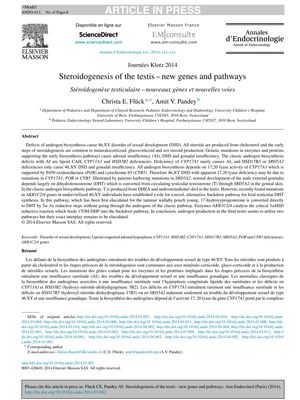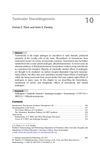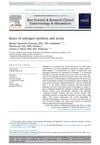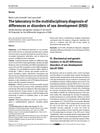Steroidogenesis of the Testis: New Genes and Pathways
April 2014
in “
Annales d'endocrinologie
”
androgen biosynthesis 46,XY disorder of sexual development adrenal insufficiency steroidogenesis lipoid congenital adrenal hyperplasia CYP11A1 HSD3B2 CYP17A1 HSD17B3 SRD5A2 17,20 lyase activity P450 oxidoreductase cytochrome b5 dihydrotestosterone testosterone AKR1C2 AKR1C4 17-hydroxyprogesterone DHT CAH POR CYB5

TLDR New genes and pathways are important for testosterone production and male sexual development.
The document discusses how defects in androgen biosynthesis can lead to 46,XY disorder of sexual development (DSD) and adrenal insufficiency (AI), highlighting the importance of enzymes and proteins in early steroidogenesis. Classic defects with AI include lipoid congenital adrenal hyperplasia (CAH), CYP11A1, and HSD3B2 deficiencies, while CYP17A1 deficiency rarely causes AI, and HSD17B3 or SRD5A2 deficiencies lead to 46,XY DSD and gonadal insufficiency. Androgen biosynthesis relies on the 17,20 lyase activity of CYP17A1, supported by P450 oxidoreductase (POR) and cytochrome b5 (CYB5), with mutations in these genes potentially causing 46,XY DSD. The document also notes the importance of dihydrotestosterone (DHT) for male genital development, which is converted from testosterone by SRD5A2. Additionally, it introduces a novel "backdoor" pathway for DHT synthesis in the fetal testis, involving AKR1C2/4 genes, which bypasses the classic androgen pathway. This alternative pathway was first discovered in the tammar wallaby and involves direct conversion of 17-hydroxyprogesterone to DHT. The exact relationship between the classic and backdoor pathways for androgen production in the fetal testis is yet to be fully understood.




